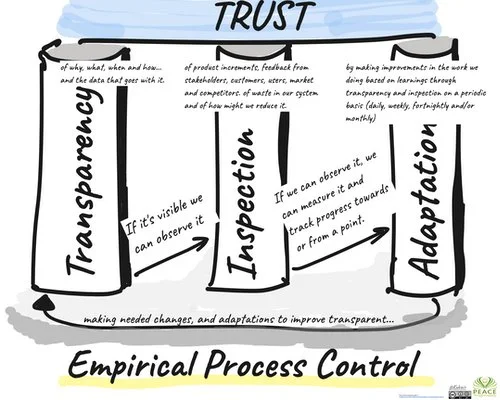The Agile Circus Is Dead: A Path to Authentic Change - Part 1
The stench of decay hangs over the Agile industry. A decade after Dave Thomas declared "Agile is Dead", we're watching the corporatised zombie shambling on – not just surviving, but thriving on Instagram filters and Pinterest-worthy Kanban boards, billion-dollar certification schemes, and framework franchises.
Yet in this decay lies opportunity.
Looking Forward, Not Back
I'm not here to judge the choices of those who came before. The past is written; what matters is what we do next.
My concern is simple:
How do we reclaim the spirit of continuous improvement?
How do we build sustainable change capabilities?
How do we grow authentic agility in our contexts?
How do we resist the pull of performative practices?
How do we co-create meaningful transformation?
These aren't rhetorical questions. They're invitations to action. They're calls to examine your own context, to question your own practices, to make your own choices.
Because while we can't change the industry's trajectory overnight, we can choose our own path. We can choose:
Substance over ceremony
Growth over compliance
Learning over certification
Context over copying
Authenticity over performance
The question isn't what others did with Agile. The question is: what will you do with it? What will I? What will we do with it?
The Numbers Don't Lie
The 2023 State of Agile Report tells an even more concerning story than before. Behind the curtain of universal adoption lies a theater of the absurd:
While 71% use Agile in their SDLC, only 44% say enterprise Agile works well for their organisations. The emperor's new clothes are showing some tears.
The market remains enormous:
Global Agile training market: $18.7 billion in 2021
Engineering/R&D adoption up 16% over previous year
Average transformation programs: $500,000 to $5 million+
But what have we bought with all this investment?
The Corporate Reality Show: Primetime Agile
Today's enterprise Agile has become a performance in three acts:
Act 1: The Implementation
Certificates matter more than capabilities
Frameworks override thinking
Tools replace conversation
Ceremonies substitute for collaboration
Compliance trumps effectiveness
Act 2: The Numbers
41% cite lack of leadership participation
38% point to inadequate management support
37% say business teams don't understand Agile
46% blame legacy systems forcing hybrid approaches
34% report culture clashes
Act 3: The Price Tag
JIRA and Agile tools revenue: $1.2 billion+ (2022)
Enterprise tool cost: $10-$15 per user monthly
Implementation costs: $100,000-$500,000
Custom integration services: $50,000-$200,000
Average transformation programs: $500,000 to $5 million+
A Tale of Two Agiles: The Great Divide
Small Organizations (Under 1,000 people):
✓ 70% report satisfaction with Agile
✓ 74% deliver on time with quality
✓ Higher transparency rates
✓ Better context adaptation
✓ Stronger value measurement
Large Organizations (20,000+ people):
⚠ 56% satisfaction rate
⚠ 62% on-time delivery
⚠ Struggle with transparency
⚠ Fight framework rigidity
⚠ Battle measurement challenges
The message is clear: Scale doesn't fail Agile. Corporate theatre fails Agile.
The Death of Simple Conversation
Watch how we've massacred the basic human act of reflection and improvement. The simple power of conversation drowned in a sea of:
Sailboat exercises when we could just talk about risks
Movie poster designs when we need to discuss delivery blockers
Star Wars themes when we should examine team dynamics
"Innovation games" that innovate nothing but meeting duration
The basic questions that drive improvement:
What worked?
What didn't?
What should we change?
Have been buried under an avalanche of:
Complex facilitation frameworks
Multiple-stage "engaging" formats
Themed exploration exercises
Manufactured metaphors
Forced fun activities
The Complexity Tax: When Simple Became Expensive
Every simple conversation now carries a mandatory complexity tax:
Stand-ups become "daily engagement ceremonies"
Retrospectives become "innovative reflection workshops"
Planning becomes "story point poker parties"
Reviews become "value delivery celebrations"
Technical discussions become "architecture building games"
What a 30-minute conversation costs in today's Agile theater:
15 minutes: Explaining the "innovative format"
20 minutes: Setting up the "engagement activity"
25 minutes: Playing through the "experiential exercise"
10 minutes: Translating metaphors back to reality
5 minutes: Actual conversation (if lucky)
Total cost: 75 minutes to achieve what a focused 30-minute discussion could deliver.
Annual waste: Thousands of hours of theatrical performance instead of productive dialogue.
The Writing on the Wall: From Rebellion to Renaissance
The numbers tell a story not of decline, but of awakening:
22% openly reject mandated frameworks
12% build their own path
34% choose freedom over franchise
This isn't the death of agility - it's a rebellion against artificial uniformity. Small companies are leading this quiet revolution, showing us what's possible when we prioritise outcomes over orthodoxy:
70% satisfaction rate versus 56% in large organisations
74% on-time delivery with quality
Higher rates of transparency and value measurement
Greater adaptability to context
They're proving what the original agilists knew: the power isn't in the framework, it's in the freedom to adapt. The death of the Agile circus isn't a tragedy - it's an opportunity. An opportunity to reclaim the essence of agility from those who turned it into a commodity.
The collapsing circus tent of corporate Agile isn't a tragedy - it's the first act of a renaissance. As we'll explore in Part 2, pioneers are already building something more authentic in its place, grounded in context, powered by capability, and measured by actual outcomes rather than framework compliance.
The question isn't whether the circus will fall. The question is: what will you build from its remains?









